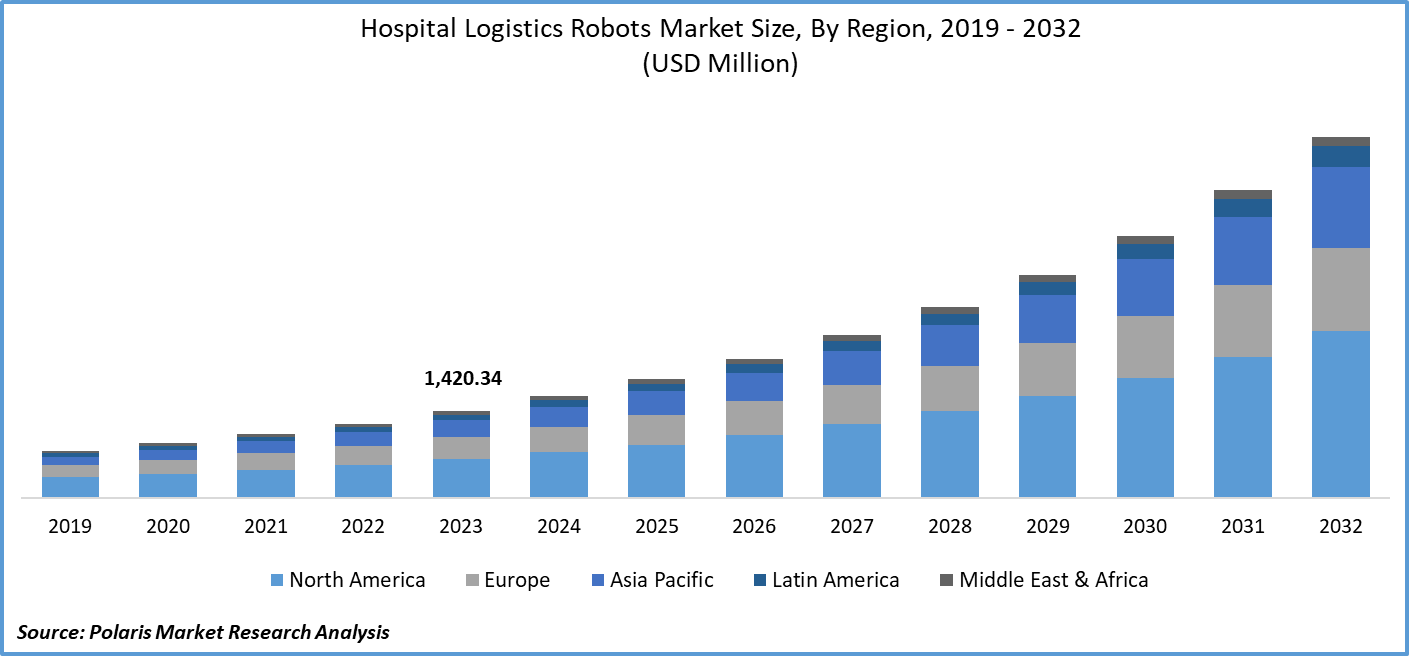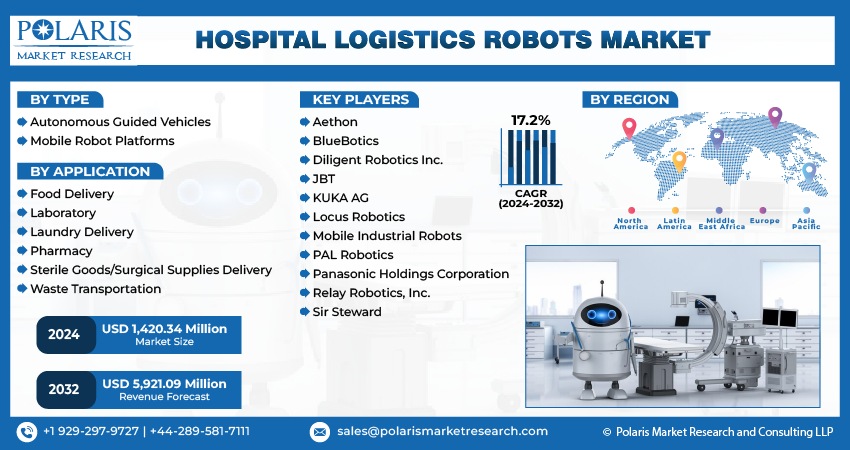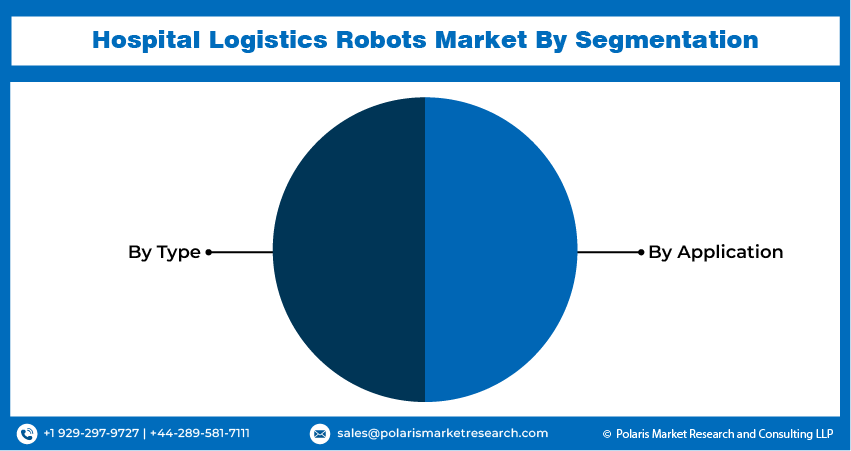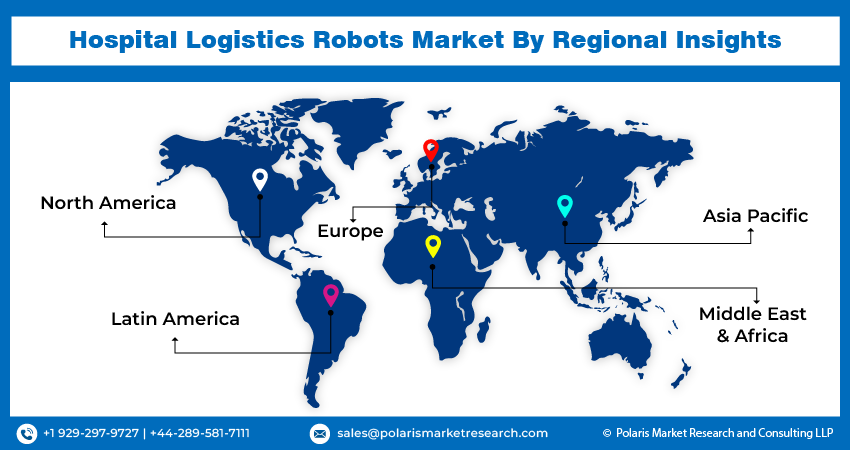
Hospital Logistics Robots Market Share, Size, Trends, Industry Analysis Report, By Type (Autonomous Guided Vehicle, Mobile Robot Platforms); By Application; By Region; Segment Forecast, 2024 - 2032
- Published Date:Mar-2024
- Pages: 117
- Format: PDF
- Report ID: PM4744
- Base Year: 2023
- Historical Data: 2019 – 2022
Report Outlook
Global hospital logistics robots market size was valued at USD 1,420.34 million in 2023. The market is anticipated to grow from USD 1,660.52 million in 2024 to USD 5,921.09 million by 2032, exhibiting a CAGR of 17.2% during the forecast period
Industry Trends
Hospital logistics robots are automated systems designed to assist with various tasks related to the transportation and delivery of goods, supplies, and even patients within healthcare facilities. These robots can help streamline operations, reduce costs, and improve efficiency in hospitals by taking on tasks such as delivering medications, lab samples, and medical records, transporting patients between rooms or floors, and restocking supply cabinets.
The hospital logistics robots market is anticipated to experience significant growth in the coming years, driven by the increasing demand for automation in healthcare facilities. As hospitals face growing patient volumes and limited staff resources, there is a growing need for efficient and reliable transportation systems to ensure the timely delivery of medical supplies, samples, and medications. Logistics robots help address these challenges by streamlining transportation processes, reducing wait times, and improving overall operational efficiency.

To Understand More About this Research: Request a Free Sample Report
Also, the advancements in technology in areas such as artificial intelligence (AI), machine learning, and sensor technologies have enabled the development of more sophisticated and capable logistics robots.
- For instance, in June 2023, EK Robotics, a German automated guided vehicle (AGV) manufacturer, introduced its latest Medi Move series of robots designed specifically for the healthcare industry. The Medi Move AGVs have advanced navigation capabilities that enable them to move seamlessly through complex underground networks and multiple floors.
These technological advancements have allowed logistics robots to navigate complex hospital environments with greater ease and accuracy and to interact with other hospital systems, such as electronic health records and supply chain management systems. However, the main restraint is the high upfront cost of purchasing and implementing logistics robot systems. Many hospitals need more time to invest in logistics robots due to the initial expense, which can include not only the cost of the robots themselves but also infrastructure modifications and staff training. Overall, the market outlook is poised for significant hospital logistics robots market growth in the coming years, driven by the need for increased efficiency and productivity in healthcare facilities.

Key Takeaways
- North America dominated the market and contributed over 40% market share of the hospital logistics robots market size in 2023
- By type category, the mobile robot platforms segment dominated the global hospital logistics robots market size in 2023
- By application category, the laboratory segment is projected to grow with a significant CAGR over the hospital logistics robots market forecast period
What are the market drivers driving the demand for the Hospital Logistics Robots market?
Increasing demand for efficient healthcare services.
As the number of people requiring healthcare services grows, healthcare providers are under pressure to deliver high-quality care while containing costs. One way to achieve this is by adopting technologies that improve operational efficiency, such as hospital logistics robots. These robots automate routine tasks, such as transporting medications, supplies, and patients, which can help reduce waste, lower labor costs, and increase productivity.
In addition, logistics robots help optimize resource allocation, streamline workflows, and enable healthcare professionals to focus on higher-value tasks, ultimately leading to improved patient outcomes. Similarly, the use of robots also contributes to enhancing the patient experience by ensuring timely delivery of essential items and reducing waiting times. With the promise of increased efficiency, cost savings, and improved patient care, the demand for hospital logistics robots is expected to continue growing, driving the development and adoption of these technologies in the healthcare industry.
Which factor is restraining the demand for Hospital Logistics Robots?
High initial investments hinder the hospital logistics robots market growth.
One of the significant factors that limit the hospital logistics robots market growth of the high initial investments associated with the purchase and implementation of these systems. The costs involved include not only the hardware and software expenses but also installation and staff training costs. These expenses can be particularly burdensome for smaller or rural facilities, and the high upfront costs can make it challenging to justify the investment in logistics robots, especially with limited budgets and competing priorities for capital expenditures. Consequently, the adoption of logistics robots in healthcare settings is limited, which, in turn, hinders the growth of the market.
Report Segmentation
The market is primarily segmented based on type, application, and region.
|
By Type |
By Application |
By Region |
|
|
|
To Understand the Scope of this Report: Speak to Analyst
Category Wise Insights
By Type Insights
Based on type analysis, the market has been segmented on the basis of autonomous guided vehicles and mobile robot platforms. The mobile robot platforms segment dominated the hospital logistics robots market due to their versatility and flexibility in automating various logistical tasks within healthcare facilities. These robots are designed to navigate through hospitals' corridors, elevators, and rooms, allowing them to transport medical supplies, samples, and even patients efficiently. They are equipped with different attachments or modules to perform various tasks such as cleaning, disinfecting, and delivering medication, making them an attractive solution for hospitals looking to streamline their operations.
Also, mobile robot platforms can be easily integrated into existing hospital systems, such as electronic health records and building management systems, which further enhances their efficiency and effectiveness. Overall, mobile robot platforms offer a reliable and efficient solution for addressing the logistical challenges faced by hospitals, which is why they have become the dominant segment in the hospital logistics robot market.
By Application Insights
Based on application category analysis, the market has been segmented on the basis of food delivery, laboratory, laundry delivery, pharmacy, sterile goods/surgical supplies delivery, and waste transportation. The food delivery segment in the market is anticipated to experience significant growth due to the increasing demand for efficient and timely food delivery systems in hospitals. With the rising number of patients and limited staff resources, it takes time for hospitals to ensure that patients receive their meals on time and in a timely manner. Food delivery robots can help address this challenge by automating the process of delivering food to patients' rooms, reducing wait times, and improving patient satisfaction.
Along with this, these robots can also help reduce labor costs associated with food delivery, freeing up staff to focus on more critical tasks. Advancements in robotics technology have made it possible for these robots to navigate through hospitals easily, avoiding obstacles and ensuring safe and secure delivery of food to patients. Overall, the adoption of food delivery robots in hospitals is likely to increase significantly over the next few years, driving the growth of this segment in the hospital logistics robots market.

Regional Insights
North America
The North American region has emerged as the leading market for hospital logistics robots globally in 2023. This growth has been primarily driven by the increasing demand for automation in healthcare facilities, primarily due to the rising labor costs and the need for efficient and error-free operations. Additionally, the presence of advanced healthcare infrastructure and high technology adoption rates in countries such as the United States has created a conducive environment for the hospital logistics robots market's growth. This development has led to North America's dominance in the hospital logistics robots market, and it is anticipated to maintain a consistent growth rate in the coming years.
Asia Pacific
Multiple factors are propelling the Asia-Pacific region's considerable surge in the market demand for hospital logistics robots in the forecast period. Governments in the region have promoted the adoption of advanced technologies, including robotics, across industries, particularly healthcare, with the aim of enhancing productivity and efficiency. Moreover, the COVID-19 pandemic has underscored the significance of contactless delivery and self-directed transportation systems within hospitals, further augmenting the demand for logistics robots.

Competitive Landscape
The global market is witnessing rapid growth, with several established players and new entrants competing to gain hospital logistics robots market share. The competition is fierce, with both established brands and startups offering innovative solutions to cater to the rising demand for automation in healthcare facilities. In particular, various startups are developing novel technologies to address specific pain points in hospital logistics. The competitive landscape of this industry is a blend of established and emerging players, all striving to provide solutions to enhance operational efficiency and patient care in healthcare facilities.
Some of the major players operating in the global market include:
- Aethon
- BlueBotics
- Diligent Robotics Inc.
- JBT
- KUKA AG
- Locus Robotics
- Mobile Industrial Robots
- PAL Robotics
- Panasonic Holdings Corporation
- Relay Robotics, Inc.
- Sir Steward
Recent Developments
- In June 2023, Relay Robotics launched a new hospital delivery robot, RelayRx, which is designed to address the nursing shortage in healthcare. The robot boasts an increased payload capacity, enabling it to transport a range of hospital items, including lab specimens, medications, and equipment.
- In July 2020, PAL Robotics, a Barcelona-based company, unveiled its latest autonomous delivery robot, specifically designed for deployment in hospitals. The robot is capable of safely picking up and delivering a wide range of items, such as Food, Medication, Lab Samples, Surgical Supplies, Bedding, and Nursing Supplies.
Report Coverage
The hospital logistics robots market report emphasizes key regions across the globe to provide users with a better understanding of the product. The report also provides market insights into recent developments and trends and analyzes the technologies that are gaining traction around the globe. Furthermore, the report covers an in-depth qualitative analysis pertaining to various paradigm shifts associated with the transformation of these solutions.
The report provides a detailed analysis of the market while focusing on various key aspects such as competitive analysis, type, application, and futuristic growth opportunities.
Hospital Logistics Robots Market Report Scope
|
Report Attributes |
Details |
|
Market size value in 2023 |
USD 1,420.34 million |
|
Revenue Forecast in 2032 |
USD 5,921.09 million |
|
CAGR |
17.2% from 2024 – 2032 |
|
Base year |
2023 |
|
Historical data |
2019 – 2022 |
|
Forecast period |
2024 – 2032 |
|
Quantitative units |
Revenue in USD million and CAGR from 2024 to 2032 |
|
Segments Covered |
By Type, By Application, By Region |
|
Regional scope |
North America, Europe, Asia Pacific, Latin America, Middle East & Africa |
|
Customization |
Report customization as per your requirements with respect to countries, regions, and segmentation. |
FAQ's
The Hospital Logistics Robots Market report covering key segments are type, application, and region.
Hospital Logistics Robots Market Size Worth USD 5,921.09 Million By 2032
Hospital Logistics Robots Market exhibiting a CAGR of 17.2% during the forecast period
North American is leading the global market
key driving factors in Hospital Logistics Robots Market are increasing demand for efficient healthcare services
